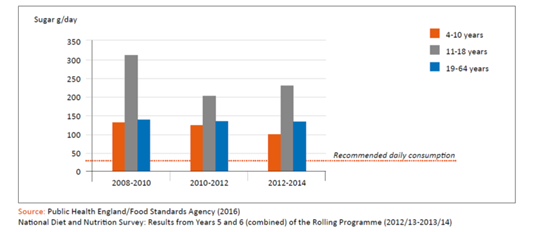Evidence from Key Data on Young People 2017
Dr Rakhee Shah, Association for Young People’s Health
The Association for Young People’s Health (AYPH) – the UK’s independent voice for youth health – has published the latest trends in young people’s health and lifestyles in a major report entitled “Key Data on Young People 2017”1. Data from this report highlights the need for further investment into more age-appropriate health promotion for young people.
Adolescence is a critical period during which life-long behaviours such as smoking, drinking, eating habits and exercise activity are set. These behaviours have an impact on longer-term health outcomes in adulthood such as heart disease, Type 2 diabetes, and cancer. It is therefore vital to make young people’s health promotion a priority. However, this often is not the case and emphasis on securing the ‘best start in life’ is often thought to mean younger children.

The report raises a number of issues, but we’d like to draw particular attention to a particular concern around young people’s diet. Only one in twelve teenagers aged 11-18 eat five proportions of fruit and vegetables a day2. Data from Key Data on Young People illustrates that teenagers aged 11-18 consume 8 times the recommended daily sugar allowance and on average consume the highest amount of sugar per day when compared to the rest of the population (Table 1)1. There has been a statistically significant reduction in sugar consumption in the 4-10 age group from 2008 to 2014, however this is not the case for teenagers.

Table 1: Sugar consumption in grams per day by age group, UK, 2008-2014
Adolescence is also a critical time when physical activity declines, particularly in young women. Data suggest that 19% of boys and only 7% of girls aged 13-15 achieve the recommended 1 hour of moderate exercise a day. This gender divide in physical activity levels continues into adulthood4, making the point for promoting physical activity in the teens.
With poor diets and declining physical activity levels through adolescence, a fifth of 11-year olds are obese in England1. Recent information from the National Childhood Measurement Programme5 indicate that there has been a small decline in number of children who are obese when starting school, but there has been no change in proportion of obese children in Year 6 (aged 10-11). These data also indicate the health of young people is not improving at the same rate as that of younger children.

Table 2: Relationship between area deprivation and prevalence of obesity and overweight in Year 6 (Age 10-11) England 2015/16
Key Data on Young People also highlights the impact that deprivation has on obesity in young people. Children in Year 6, living in the most deprived areas are twice as likely to be obese when compared to children living in the least deprived areas (Table 2). I would therefore argue that policies that will improve young people’s socioeconomic position and reduce socioeconomic inequalities will be more effective at promoting adolescent health than targeting individual behaviour. This may also have an impact on reducing other risky health behaviours related to deprivation including smoking, unprotected sex and mortality related to road traffic accidents.
References:
- Hagell A, Shah R and Coleman J (2017) Key Data on Young People 2017. London: Association for Young People’s Health. http://www.youngpeopleshealth.org.uk/key-data-on-young-people.
- Public Health England (2016), Food standards Agency National Diet and Nutrition Survey Results from Years 5 and 6 (combined) of the Rolling Programme (2012/2013 – 2013/2014) London: PHE.
- Brooks, F., Magnusson, J., Klemera, E., Chester, K., Spencer, N. and Smeeton, N. (2015). HBSC England national report 2014. Hatfield, UK: BMJ Publishing Group.
- British Heart Foundation (2017) Physical Inactivity and Sedentary Behaviour Report 2017.
- Public Health England (2017) National Child Measurement Programme Changes in children’s body mass index between 2006/07 and 2015/16 Detailed Report.